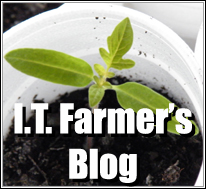Along with the Brush Hog, and Finish Mower, the Tractor has another attachment that I thought was kinda useless. The attachment looks like a straight piece of metal attached to the three point hitch. I have seen it used in the past to level gravel, or to move snow, but I didn’t really appreciate how awesome this piece of equipment was until I got on the tractor and taught myself how to use it.
I decided that I had looked at a few piles of top soil for too long, and that this blade might be useful in leveling out the dirt. In an hour or so, I conquered the first small pile of dirt, and was leveling the ground nearby as well. It was kinda fun to level dirt when I didn’t need a shovel and wheel barrel !
After the initial success, I decided to use the blade to knock over some brush. The brush had been allowed to grow since it was known there were chunks of metal in this area that would do some serious damage to a lawn mower. Once the brush was clear, I could see the metal pipes and cables, to which my mind immediately pictured more work then I wanted to do.
I made a calculated guess that I could pull these chunks of metal out of the ground with the tractor, but I also figured there could be a high cost if I guessed wrong, so I started small, and soon found myself ripping and tearing till the whole area was flat, clear of debris and ready for some grass seed.
I managed to pull all of this metal from about a 150 square feet of ground. It has already been sent for recycling, and I’d guess it’s on a ship headed for China, where it will be made into the axles for toys in fast food smile meals….
After removing all of the metal, and leveling the soil with the tractor, I needed to finish the job right by using a shovel and rake to make the ground smooth as any suburban lawn. I found myself shoveling wheel barrel after wheel barrel of soil, but I attracted some unexpectedly chipper helpers. Jessica, my niece, and the little gardener made a huge contribution leveling the soil as I dumped it. As always, I couldn’t believe the level of effort put forth especially by my 6 year old helper. He has since asked me if we could do some more dirt leveling, and amazing commitment if you ask me.
After cleaning everything up to the patch of trees shown, I decided to keep going, and started leveling the ground and ripping up any iron found. With Nate’s help we removed a whole lot of old trees and limbs, and I’ve brought down my Bio-Char barrel for some finish up work. I hope to place another barrel next to the one shown, and try out a double burn. This should give me more bio-char for the amount of fuel burnt. All of the brush Nate and I cleaned up will hopefully be turned into bio-char, and spread either over the barren ground here on in the garden.
I had set out to level two hills of soil, but instead I’ve made quite a mess stretching about two hundred feet long and 50 feet wide. I need to repair a flat on the tractor, then I can continue this project. I’ve already begun planting grass seed in the first portion, and covering it with hay.
When I’m all done leveling the ground, I hope to plant fruit trees the whole length of the driveway on the right, and a wide selection of native trees by the crick which runs through the valley on the left. Some of the native trees I hope to plant include Weeping Willows, which should help trap moisture in the valley instead of it running off during dry months. I may even throw in some cherries and berries as part of the final plan, but I guess I should get my ducks in a row and get back to work starting with a tire repair on the tractor.


















































